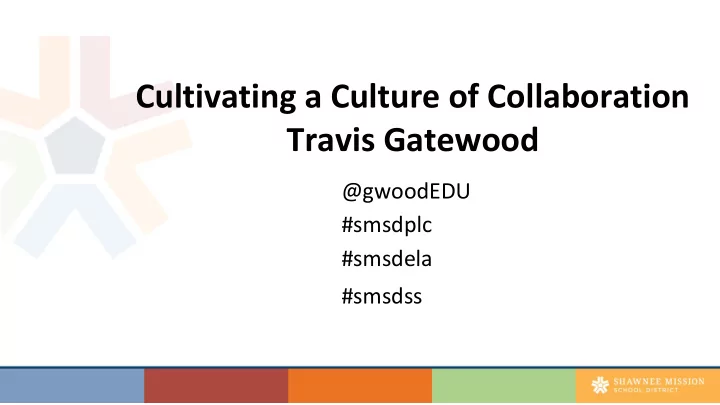

Cultivating a Culture of Collaboration Travis Gatewood @gwoodEDU #smsdplc #smsdela #smsdss
PLC - Introduction Name Building Role What is a win from the school year? What do you want to get from the day?
PLC - 1 * 5 * 10 Are we a group or a team? The 1 - 5 - 10 Paradigm http://www.allthingsplc.info/files/uploads/1-5-10-plc-rubric.pdf Where is your PLC for each item on the 1-5-10 Rubric?
PLC - The Four Cornerstones Mission - Why? - Why do we exist? Vision - What? - What do we want to become? Values - How? - How will we act to achieve our purpose? Goals - How? - How will we know if it is working? South ELA Example Profile of a Graduate 21st Century Skill Sets
PLC - The Three Big Ideas A focus on learning Communication - The Why A culture of collaboration Trust building and capacity building - The Who and The How A results orientation Accountability - The Do
PLC - The Four Questions What do we want students to learn? - Curriculum How will we know when they learn it? - Assessment What will we do if they have not learned it? - Intervention What will we do if they have learned it? - Enrichment Within classroom - Station rotations, individualized instruction Outside classroom - Student Intervention Team, Targeted seminars MTSS Pyramid
PLC - Priority Standards & Common Assessment Formative (Practice) = Feedback - Real-time, Responsive Summative (Performance) = Scoring - Product, Measurement Priority = Up (Endurance) * Across (Leverage) * Out (Readiness) PLC = Assessment/Rubric/Calibration/Data Analysis/Student Work
PLC - Curriculum Maps Where are we with standards and pacing? With resources and strategies? Big Picture Curriculum Map as Living Document ELA 3 Example
PLC - Formative Assessment Examples 56 Formative Assessment Examples https://raiderwritingcenter.files.wordpress.com/2015/09/formative- assessment-56-examples-david-wees.pdf
PLC - Writing Rubric Example Sample Writing Rubric https://raiderwritingcenter.files.wordpress.com/2017/08/raider-writ ing-rubric.pdf
PLC - ELA Analysis Summative Assessment 2008 AP Lang and Comp, “America Needs Its Nerds” Prompt https://secure-media.collegeboard.org/apc/ap08_eng_lang_form_b _frq.pdf Rubric Samples https://secure-media.collegeboard.org/apc/ap08_english_lang_for m_b_q2.pdf
PLC - Late Start Template Nuts and Bolts (5 mins) Wins and Issues (5 mins) Resources and Strategies (10-15 mins) = Rotate classrooms and presenters The Work (45-60 mins) Clarify standards / Share practices / Solve problems / Build assessments / Analyze data / Identify students / Celebrate wins = Make a topics schedule
PLC - Summative / Performance Examples Summer Homework Get into the AP Website Look for your subject Use their materials to support your instruction AP Macroeconomics Example https://apcentral.collegeboard.org/courses/ap-macroeconomics/exa m
PLC - Sample Documents PLC Mission and Vision PLC Elements PLC Norms PLC Checklist PLC Standard and Strategy PLC Common Assessment Protocol
PLC - First Meeting Create a rotation schedule Distribute hard copies of curriculum maps Set norms / collective commitments *Put a big circle in the middle of a sheet of paper *Everyone takes two minutes to write on the outside of the circle their values and expectations for what makes a good teacher and teammate *After two minutes, everyone shares their ideas – Place any commonalities/threads inside the circle *Make a final list of your collective commitments *Use these commitments as an objective way to guide team actions/behaviors throughout the year
PLC - Ongoing Meetings What do we want our classrooms to look like for our students and for us? What does effective instruction look like? What performances will we use to evaluate and enhance student learning? What is our plan for intervening when students struggle? How can we extend and enrich students’ learning experiences? How do we celebrate the wins for our students and staff? =Deliver a guaranteed, viable curriculum - Curriculum Page
PLC - Final Questions Why do our students fail? What is preventing us from becoming the school we wish to become? Predictable is Preventable
PLC - Good to Great You must maintain unwavering faith that you can and will prevail in the end, regardless of the difficulties, and, at the same time, have the discipline to confront the most brutal facts about your current reality , whatever they may be” (Jim Collins).
PLC - Good to Great What are some brutal facts?
PLC - What Students Want in a Teacher • Do meaningful work • Practice trust and respect • Have clear expectations • Be interactive • Allow for multiple perspectives / voices • Show empathy • Teach with passion and interest • Create structure with some flexibility • Know content • Use examples / models
PLC - What Does Learning Look Like? Provide mental models Create intrinsic motivation (choice / audience / relevance) Establish a positive environment (attitude / expectations / respect) Set vision and targets Celebrate the wins
PLC - Notes on Motivation Have a vision and momentum for the class (show relevance and importance) Have a positive and respectful attitude towards students (use adult voice) Take time for celebrations (make them feel a part of something bigger) Be present and respectful Be a coach and mentor - “I am not going to give up on you”
PLC - The Variables Uncontrollable Variables Controllable Variables Children cannot control - Teacher teams can develop - Their parents A school and classroom culture of care and encouragement Where they live A guaranteed, viable curriculum The school they attend Effective, research-based teaching strategies Their teachers Common formative assessments The high-stakes summative tests they take Systems of providing additional time, support, and enrichment Recognize and celebrate improvement
PLC - Notes on Motivation EMOTIONS INTEREST IMPORTANCE SELF-EFFICACY Use effective pacing Use games Connect to student Help students to lives believe in their Incorporate physical Initiate debate ability to perform a movement Connect to student task Present novel ambitions Demonstrate intensity information Model skills and and enthusiasm Encourage examples of Ask questions application of self-efficacy Use humor (not learning targeted sarcasm) Make connections Provide effective, ongoing feedback Build positive relationships through Track and reflect on respect and empathy progress Set goals for class
For More Information: Travis Gatewood Phone: 913.993.6406 Email: travisgatewood@smsd.org Twitter: @gwoodEDU
Recommend
More recommend